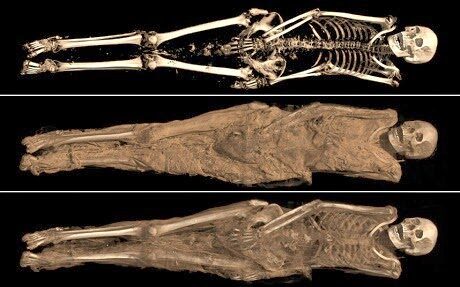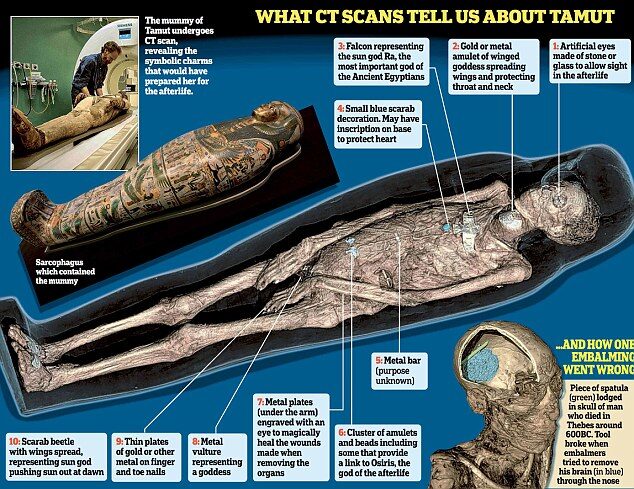When Napoleon Bonaparte invaded Egypt in 1798, he was accompanied by 167 scholars, his Commission on the Sciences and Arts. Their work revealed a dazzling world of ancient temples and tombs to European eyes. The expedition’s results, published in the 23-volume Description de l’Égypte, made Ancient Egypt fashionable. The rage for collecting Egyptian antiquities, and the race to fill European museums with them, had begun. Ancient Egypt entered popular culture, and its remains are still familiar today: mummies in magnificent decorated coffins, funerary masks, hieroglyphs. The Rosetta Stone, one of the most iconic Egyptian antiquities, was discovered by Bonaparte’s Commission, captured as a war-trophy and is now on display at the British Museum. The Stone was central to deciphering hieroglyphs, helping scholars to understand this ancient world. In a fascinating exhibition at the same institution, eight mummies, whose secrets are being unlocked by cutting-edge technology, prove themselves to be key to new insights into Egyptian lives and culture.

Source: Archaeologynewsnetwork
The exhibition begins with an image of family life: a statuette of a priest and his family, apparently in their prime. Yet this was placed in a tomb, perpetuating a memory of pristine youth. The whole display is about the interplay between life and death, representation and reality, realised through human remains, artefacts and visualisation technology. The mummies themselves have never been unwrapped, for fear of damaging them. The advent of CT scans now allows experts to look inside in incredible detail without harming them. At the most basic level, they help us to begin to visualise people: we learn ages, sex, heights and about some of their ailments. The CT scans sometimes expose the gap between what is represented on coffins and what lies inside. One coffin of a woman actually held the body of a man. Skilfully treated, carefully mummified and beautifully wrapped, the scan nonetheless reveals that part of his brain – and a tool – had been left behind in his skull. Padiamenet, a temple doorkeeper – was not so lucky. The serene exterior of his coffin hides the fact that his body was shoddily treated after death: the embalmers needed rods to reattach his head to his body after it fell off. To add insult to post-mortem injury, his feet projected out at the end of his coffin and had to be covered with cloth.
.jpg)
.jpg)
Source: TimeOut
If these bodies form a highly emotive and informative link between past and present, their lives are a point of connection to Egyptian culture more broadly. Through Tjayasetimu, a 7-year-old temple singer, we learn about music, an array of instruments arranged behind the showcase glass, tantalising in their silence. Again there is a disparity between the representation on her coffin and the body within: the coffin depicts a mature woman, whose unwrapped hands and feet signal life, not a dead child whose adult teeth are still waiting to erupt in her jaw. The length of the hair that still remains on her head leads to a discussion of hair’s symbolic importance. The way in which hair was dressed reflected age, gender and social status: young children had their hair shaved; the wealthy wore elaborate wigs, an astonishing example of which is on display, a profusion of curls and plaits made up of hundreds of human hairs. The tiny coffin of a toddler from the Roman period emphasises the importance of the family to the Egyptians, the nearby toy mouse and wooden horse shrinking the two-thousand-year gap between them and us.

Source: TheDailyMail

Source: DesignWeek
Museums and technology are not always the happiest of bedfellows. There is a danger of gimmickry, and the inevitable but frustrating risk of things breaking down. Here, there is a sympathetic balance because what the technology can reveal is totally new and fascinating, and it is elegantly incorporated into the exhibition design. Along with the CT scans, many of which the visitor can explore for themselves, there is sparing use of 3-D printing, allowing us, for example, to see replicas of the amulets still preserved in the wrappings around the body of priest’s daughter Tamut, their hidden forms revealed after millenia by the CT scans.
Exhibitions about the past have to tread a fine line between strangeness and familiarity. There needs to be a point of connection for us to care about lives lived thousands of years ago, something about the experience of being human that survives the passage of time. Being able to picture Ancient Egyptians as people, through understanding more about their bodies, is a first step. Yet these eight people came from a very different culture and belief system, where the dead might see with incredible powers and become transformed into immortal beings. Through objects, technology and the bodies themselves, this exhibition provides an absorbing view of ancient Egypt that left me wanting to know more.